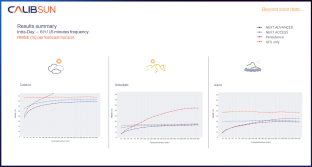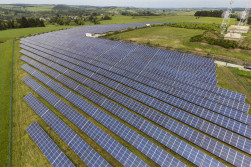Storage and PV: what opportunities?
 4 Mai 2023
4 Mai 2023
 4 Mai 2023
4 Mai 2023
The production of carbon-free energy from solar power depends on the amount of sunlight received by the photovoltaic panels during the day. In addition to day/night intermittency, yield is not linear over the course of a day, but parabolic. The variability of PV plant output is also impacted by climatic variations : temperature, cloud cover and humidity are all factors that cause output to fluctuate.
Clouds have the most significant impact, as they can block or reduce the amount of photons reaching the solar panels. Although simulations of cloud formations are becoming increasingly accurate, it remains difficult to predict with a high degree of precision the appearance and movement of clouds over a highly localized area. In fact, satellite imagery and weather projections are unable to anticipate the appearance of clouds, their formation and movement, which depend on very local conditions of humidity, convective currents and temperature. Its integration into the power grid therefore depends on managing its variability and balancing supply and demand to deliver the power needed for human activity at all times.





Industry is the main sector impacted by the reduction of greenhouse gases, and will have to reach 30% renewable energy (RE) in its energy mix by 2030.
However, the growth of renewable energies in the energy mix needs to be seen in the context of the global rise in energy demand. Indeed, the growth of photovoltaic energy is complementing the new energy needs of industries, notably IT, but the partial replacement of fossil energy use by renewable energy is often a constraint for an energy-intensive industry that operates continuously.
Sites connected to the energy grid
For industrial companies with self-consumption photovoltaic systems connected to the grid, power fluctuations are compensated for by the external supply of energy, the mix of which depends on the grid operators. By ensuring that power is maintained, PV makes it possible to make substantial savings, meet decarbonization objectives and enter into a virtuous process for the company.
Isolated sites
For isolated industrial sites with no access to a stable electricity grid, the energy supply often comes from generators powered by fossil fuels. Polluting, expensive and requiring extensive supply logistics, they can be replaced by solar energy if the geographical location allows it. This alternative is all the more profitable as it means we are no longer subject (partially or totally) to fluctuations in energy prices.
On the other hand, it requires excellent management to avoid power drops and maintain activity independently of climatic conditions and the appearance of clouds. Manufacturers must therefore incorporate into their energy mix an alternative source capable of delivering the necessary power.
Energy storage: the solution
The need for energy storage is a response to economic, environmental, geopolitical and technological challenges.
With the need to maintain continuous production, to limit dependence on fossil fuels and to reduce costs, manufacturers are turning to storage solutions. In recent years, the solar industry has made major technological breakthroughs in solar resource forecasting and the creation of PV energy storage systems to prevent power drops and limit losses. Solar energy is stored when its availability exceeds requirements, and is released when the power of the solar panels is insufficient.
Storage must be dimensioned to meet the needs of the industrial site. Lithium-ion batteries currently dominate the market, offering the best performance and flexibility, but other types of electrochemical batteries are also available. Hydrogen storage is promising, with numerous R&D efforts underway on fuel cells and electrolyzers. Whatever storage solution is chosen, it must be accompanied by an EMS (Energy Management System) and a weather forecasting service on several time scales. These are needed to determine expected production in advance and manage the storage system, which will charge or discharge according to the forecast.
CalibSun: from forecasting to detection
Pour les sites isolés, le stockage doit être capable de palier à l’apparition d’un nuage obstruant le soleil durant For isolated sites, storage must be able to compensate effectively while clouds are blocking the sun for a short time, as well as for overcast weather lasting several days. CalibSun supports manufacturers using solar energy for self-consumption with its resource forecasting tool, coupled with a highly accurate, local detection service operating in real time, to anticipate power drops linked to the appearance of clouds.un court moment autant que par ciel couvert sur plusieurs jours. CalibSun accompagne les industriels exploitant l’énergie solaire en autoconsommation grâce à son outil de prévision de la ressource, couplé à un service de détection très précis et local fonctionnant en temps réel, pour anticiper les chutes de puissance liées à l’apparition de nuages.


 de
de 
 en
en fr
fr es
es



